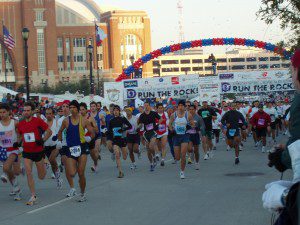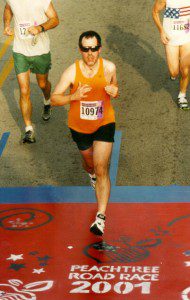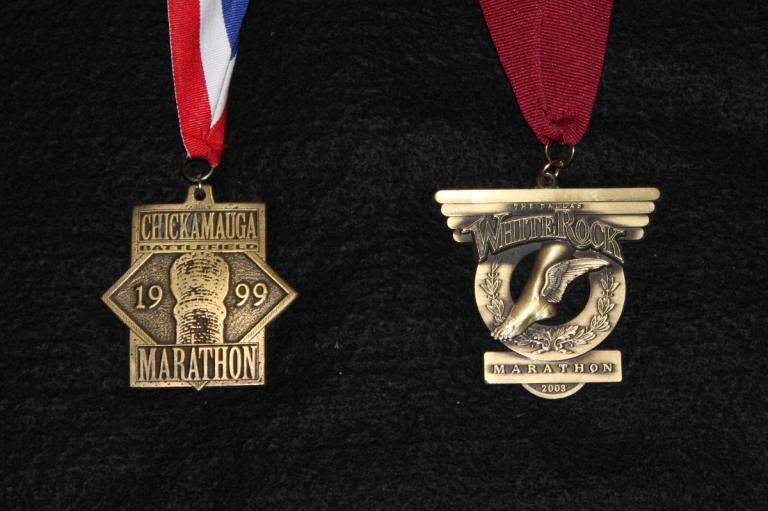
This Saturday marks ten years since I ran my second and final marathon. Though injuries and weight gain forced me to stop running long ago, my brief running “career” remains one of my most meaningful personal achievements.
Last year I told my running story in the context of a wider discussion on fat and health. Go read it if you’re interested – here’s an excerpt.
Growing up I always felt like I was inferior because I wasn’t an athlete. Running changed all that. I still wasn’t very fast, but with amateur distance running you don’t have to be fast. You just have to keep going. I gradually stretched out from a mile to two to three. When I ran four miles for the first time in my life at the age of 36 I knew I was on to something. I went from exercising to training. I kept training logs. I bought running clothes. I started signing up for races. I was doing something “normal” people couldn’t (or wouldn’t) do. I was finally an athlete.
In 1999 I ran 20 to 40 miles per week. That November I ran the Chickamauga Battlefield Marathon in 3 hours and 58 minutes. I was thrilled, and I had dreams of qualifying for the Boston Marathon.
Two months later I had my first serious running injury – plantar fasciitis.
Over the next five years I kept running while I tried various combinations of rest, stretching, orthotics, medication and ice treatments. My mileage went down and my weight went up. I ran the Dallas White Rock Marathon in December 2003 in 4:20.
By then more than my right foot was hurting. I was constantly tired and I was tired of training. I kept cutting back and cutting back and my weight was creeping up. The last entry in my running log was a 7 mile run on September 19, 2004. I kept meaning to pick it up again, but I never did.
Ten years feels like a significant anniversary. It also feels like it’s been long enough to make some useful observations on what I learned from the whole process.
The human body is a magical thing. The magical tradition has its stories of wonder working mystics, stories that even those of us who practice diligently view with a skeptical eye. But every year, hundreds of thousands of ordinary people run a distance (26.2 miles) most of us find impossible. It’s not for nothing that the inspiration for the modern marathon – the story of Pheidippides running from Marathon to Athens to report that the invading Persians had been defeated – ended with the runner dropping dead.
In a recent post I gave the classic definition of magic: “the Science and Art of causing Change to occur in conformity with Will.” Training for a marathon is a magical working. It makes you wonder what else we think is impossible is merely improbable, awaiting only the proper application of science, art, and will to manifest it in this world.
The human body has limits. Any system eventually runs up against its limits. The marathon is infamous for “the wall” – the point at which the body exhausts its supply of glycogen and no longer has the energy to keep running at the previous pace. That’s generally around 20 miles. I breezed by 20 miles in both my marathons, then hit the wall at 22 and had to slow drastically.
There are individual limits and there are cumulative limits. I ran into a limit on training – if I ran enough to complete a marathon, I got injured. That’s the knife edge elite athletes must walk. Train just a bit too hard and you get injured. Train just a bit too light and you get beat.
Your limits are usually far beyond what you think they are, but when you reach them, they’re real.
The value of sustained, consistent practice cannot be overstated. There are “couch to 5K” programs all over the country that can take a sedentary but otherwise healthy person from doing nothing to running 3.1 miles in a few months. There are “5K to marathon” programs that will take a novice runner to a marathon finisher in several more. These program are built on a commitment to run 3 or 4 days a week, every week. All the rest – diet and stretching recommendations, group runs, charity fundraising, goal races – are tricks to keep the aspiring runner running regularly. You can skip a run here and there, but skip a week and you’ll find yourself more than a week behind schedule.
Try to move beyond simply finishing to finishing in a certain time and more training is required. You may need years of gradually increasing mileage to reach your ultimate goals.
How long do you think a virtuoso musician has practiced? A martial arts master? A great ritual leader?
How long do you think those wonder working mystics have practiced?
Becoming competent at anything is a matter of a little regular practice. Being as good as you can be? That takes much longer.
 Don’t quit. We’ve all heard “the first step is the hardest.” If you’re dealing with fear, sometimes that’s true. Most times, though, the first day’s running is easy. What’s hard is getting out there on the second day when you’re stiff and sore and still a little tired from yesterday. What’s hard is going out there day after day, week after week, in heat and cold, rain and snow, and doing what you said you wanted to do. I wanted the experience of running a marathon, so I kept it up.
Don’t quit. We’ve all heard “the first step is the hardest.” If you’re dealing with fear, sometimes that’s true. Most times, though, the first day’s running is easy. What’s hard is getting out there on the second day when you’re stiff and sore and still a little tired from yesterday. What’s hard is going out there day after day, week after week, in heat and cold, rain and snow, and doing what you said you wanted to do. I wanted the experience of running a marathon, so I kept it up.
Starting a Pagan practice is easy. What’s hard is sitting in meditation night after night. What’s hard is making regular offerings and devotions. What’s hard is engaging in reflection and contemplation and study and all the things that fall under the category of spiritual practice. But if you want to be a competent Druid or Witch or other Pagan practitioner, keep it up.
Know when to quit. Some things – and some people – are part of your life forever. Other things and other people come in and even though they’re meaningful and helpful they aren’t meant to last. Clinging to things past their time is rarely helpful.
Running let me be an athlete for a few years – I can’t tell you how important that was for me. But if I was still trying to be an athlete I wouldn’t have the time and energy to be the Druid I’m called to be… not to mention the fact that my body was telling me it’s not cut out for regular distance running.
I still walk regularly. It’s good exercise, it’s low impact, and I enjoy it. It’s part of my regular spiritual practice. But I’m not an athlete any more.
There is value in doing something for yourself. Distance running is perhaps the most solitary of sports. While it’s easy to start, getting better requires a significant commitment in training time, recovery time, diet, and the constant demand of the schedule. These commitments can have an impact on friends and family who don’t share your passion. And then there are the killjoys who claim that runners are narcissists who waste time on themselves.
Anything can be overdone. But proper self-care is a necessity if your life is to be as effective and as meaningful as it can be. We need the basic necessities of life. We also need art, music, good food, and love. All of us need exercise – some of us need training and competition.
Proper self-care equips us and energizes us for service to our gods, our communities, and our world.
Sometimes I wonder if things would have turned out differently if I had never gone past a half marathon. Could I have avoided injury and kept running? Or would I have stopped even sooner without the carrot of the marathon constantly in front of me? I suppose I’ll never know.
But I know this: running gave me some great experiences and taught me some valuable lessons.

















